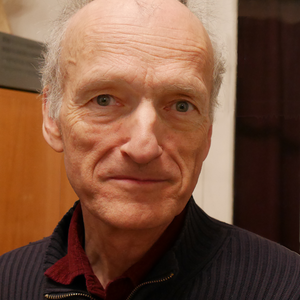Denis Dufour (b. 9 October 1953, Lyons) is recognized as a composer in the field of instrumental as well as electronic creation for concert with more than 180 works to his credit. As one of the pioneers of the 'morphological' and expressive approach to sonic writing, his works employ a wide spectrum of parameters in all sonic dimensions, contributing to the emergence of a genre that decisively connects all the arts with his interdisciplinary approach to composition and pedagogy. The exploration of new structures of sound, the fluidity of a 'Baroque' style of phrasing, the mobility of his figures, and his love of the human voice and of certain dramatic narrative effects have fostered a new kind of theatrical sound in his work, over and beyond his strictly musical discourse.
Despite his large compositional output, from the late 70's, he was a teacher at the Paris Boulogne-Billancourt Higher Arts Education Centre (PSPBB), the Regional Conservatories of Paris, Perpignan, Lyons and the Paris Conservatoire (CNSMDP), a researcher (including the GRM – Musical Research Group – until 2000) and a lecturer. He has also led many courses, workshops and masterclasses in France and abroad. Through his actions and pedagogy he played a key role in the development of acousmatic art and its growth, especially in Italy and Japan since the early 2000s. He himself studied the classics at the CRR in Lyons and the CNSMDP.
Founder and initiator of the TM + ensemble in 1977, his work Ourlé du lac à la première goutte de pluie (Pli de Perversion 2) performed at the ICMC in 1984 – is the first to use Syter, one of the first real-time digital processing devices. Dufour was instrumental in identifying the need to add a graphical interface to be able to play the parameters quickly and accurately. It was this observation that led to the development of the ‘interpolations screen’, which can memorise the status of all the system's parameters (a “snapshot”, as we would now call it), and enables the user to move very quickly from one configuration to another by jumps or interpolations (gradual evolution). He also contributed significantly to the realization of the Acousmographe, a software for graphical representation of sound phenomena, produced by Institut National de l'Audiovisuel (INA).
An organizer and artistic director of several events dedicated to contemporary instrumental and electroacoustic creation (the series Acore in Lyons, Syntax in Perpignan, Musiques à Réaction in Paris, Futura Festival in Drôme), he also founded several organisations, groups and instrumental ensembles that continue to contribute the musical life in France and worldwide (Motus, Futura, Syntax, TM+, Ensemble Linea, Les Temps modernes…). Through Motus, since 1996, he initiated two of the most important acousmoniums performing regularly in France and in Europe. Several annual interventions, particularly the invitation to the Palais de Tokyo have contributed to the reputation of Motus in the world of contemporary art.
Recognizing the need to broaden the scope of a type of creation made in a studio, fixed on a medium and delivered for listening on loudspeakers, he combined the various genres into what he calls Acousmatic Art, which offers an open definition (translated into several languages) and which is beyond mere musical terrain. In his hands, acousmatic art came to being a fertile musical genre, which, consciously or not, influenced a number of musicians and artists. Very aware of promoting cross-practice, he is involved in multiple partnerships in the visual arts (Galerie Lydie Rekow at Crest High School Art Perpignan, initial three years residence in the centre of contemporary art at the Domaine de Kerguéhennec, collaboration with visual artist Jaume Xifra and with Richard Serra in Monumenta 2008).
His instrumental, mixed and real-time works are published by Maison Ona (www.maison-ona.com) and his acousmatic works by Opus 53.
Après des études classiques aux CRR de Lyon et CNSMD de Paris, Denis Dufour [1953, Lyon] est devenu un créateur sonore reconnu tant dans le domaine de la musique instrumentale que dans celui de l'art acousmatique, avec plus de 180 œuvres composées à ce jour. Parmi les pionniers de l’approche ‘morphologique’ et expressive du son, incluant dans son travail le plus large spectre des dimensions du phénomène sonore, il a contribué à faire émerger un genre musical fertile qui influencera consciemment ou non de nombreux musiciens et artistes. Il est, depuis la fin des années 70, enseignant (Pôle supérieur d'enseignement artistique Paris Boulogne-Billancourt, Conservatoires régionaux de Paris, Perpignan, Lyon et Conservatoire national supérieur de Paris), chercheur (notamment au GRM jusqu’en 2000), conférencier et anime nombre de stages, ateliers et master classes en France et à l’étranger. Par ses actions et sa pédagogie il joue un rôle essentiel dans le développement de l'art acousmatique et à son essor, particulièrement en Italie et au Japon. Organisateur et directeur artistique de nombreuses manifestations dédiées à la création contemporaine (cycles Acore à Lyon, Syntax à Perpignan, Musiques à réaction à Paris, festival Futura dans la Drôme), il est à l'origine de plusieurs structures, collectifs et formations instrumentales qui continuent d'irriguer la vie musicale en France et dans le Monde (Motus, Futura, Syntax, TM+, Ensemble Linea, Les Temps modernes…). Ses œuvres instrumentales, mixtes et ‘temps réel’ sont éditées par Maison Ona (www.maison-ona.com) et celles acousmatiques par Opus 53.

